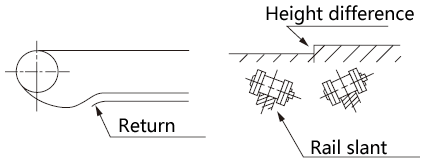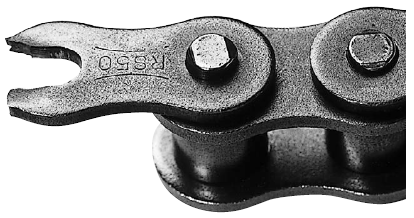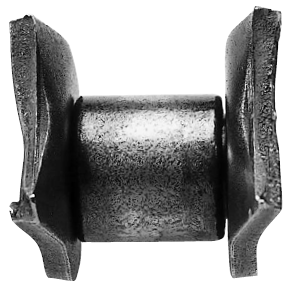Troubleshooting Small size conveyor chain
When there is significant damage or breakage to the chains or sprockets, carry out the following remedies or replace with new chains and sprockets as necessary.
General
Plate related
Pin related
| 12 | Breakage of pin |
|---|---|
| 13 | Pin rotates or begins to protrude |
Bush/roller related
| 14 | Roller and/or bush cracks (falls off) |
|---|---|
| 15 | Roller does not rotate, or unsymmetrical roller wear |
| 16 | Roller is opening up |
| 17 | Roller is becoming hourglass shaped |

General
| 1 |
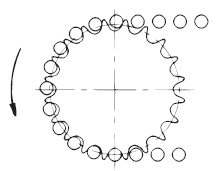 [Click to enlarge ] |
Chain is riding up on the sprocket |
|---|
| Cause 1 | Chain and sprocket do not match | Solution | Replace the chain or sprocket with the correct size. |
|---|---|---|---|
| Cause 2 | Excessive load | Solution | Decrease the load (and consider pump lubrication), or increase the number of strands or size of the chain. |
| Cause 3 | Chain wear elongation or excessively worn teeth | Solution | Replace with new chains and sprockets. |
| Cause 4 | Insufficient chain winding angle | Solution | Set angle to 120° or more, or for three teeth or more. |
| Cause 5 | Insufficient back tension | Solution | Set or adjust the catenary and take-up. |
| Cause 6 | Center distance between chain and sprocket shaft | Solution | Inspect and adjust. |
| 2 | Unusual noises |
|---|
| Cause 1 | Improper installation of the sprocket or shaft | Solution | Inspect and correct |
|---|---|---|---|
| Cause 2 | Chain casing or bearings are loose | Solution | Tighten all bolts and nuts. |
| Cause 3 | Excessive/insufficient slack in chain | Solution | Adjust the distance between shafts to obtain the proper amount of slack |
| Cause 4 | Excessive chain or sprocket wear | Solution | Replace with new chains and sprockets. |
| Cause 5 | Lack of or unsuitable lubrication | Solution | Provide proper lubrication according to the operating conditions |
| Cause 6 | Chain or drive area interfering with the casing. | Solution | Inspect and adjust. |
| Cause 7 |
Guard rail not properly installed |
Solution | Inspect and adjust. |
| 3 |
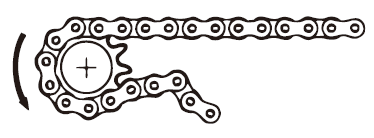 [Click to enlarge ] |
The chain winds onto the sprocket. (Poor separation from sprocket teeth.) |
|---|
| Cause 1 |
Excessive chain slack |
Solution | Adjust the chain length or distance between shafts Install a tensioner |
|---|---|---|---|
| Cause 2 | Chain wear elongation or excessively worn teeth | Solution | Replace with new chain or sprocket |
| Cause 3 | Chain and sprocket do not match | Solution | Replace with new chains and sprockets. |
| Cause 4 | Poor articulation due to rust Insufficient lubrication or poor environment |
Solution | Replace the chain and protect the chain from the environment through lubricating or installing a casing. |
| 4 | Wear on the inside surfaces of the link plates and sides of the sprocket teeth. |
|---|
| Cause 1 | Improper installation | Solution | Correct sprocket and shaft installation |
|---|---|---|---|
| Cause 2 |
Chain is being pushed laterally. |
Solution | Remove the cause of the lateral forces and switch to a chain with guide rollers. |
| 5 | Excessive wear on the link plate side surfaces and pin heads |
|---|
| Cause 1 |
Improper installation of guides, etc. |
Solution | Check the condition of the guide and widen the space between guide and chain. |
|---|
| 6 |
 [Click to enlarge ] |
Poor chain articulation |
|---|
| Cause 1 | Deformation of chain due to inproper installation | Solution | Inspect the installation and correct as necessary |
|---|---|---|---|
| Cause 2 | Contamination from wear dust or dirt due to improper lubrication (grease, etc.) | Solution | Remove the chain, clean, and lubricate appropriately. |
| Cause 3 | Overload, pin bending, bush cracking | Solution | Reduce the load, or increase the chain size or number of strands. |
| Cause 4 | Corrosion or rusting | Solution | Install a casing to protect the chain |
| Cause 5 | Insufficient lubrication | Solution | Lubricate sufficiently. |
| Cause 6 | Foreign matter or conveyed goods caught in the clearances between pins, bushes, and rollers. | Solution | Install a casing to protect the chain |
| Cause 7 | Usage in high temperatures | Solution | Contact a Tsubaki representative to ensure that the clearances are appropriate. |
| 7 | Spreading of link plates |
|---|
| Cause 1 |
Uneven or excessive loading caused by improper installation |
Solution | Replace with a new chain and adjust the installation. |
|---|
Plate related
| Cause 1 | Excessively large shock load | Solution | Reduce shock loads by making the start-up, stopping, and other actions smoother (by installing a shock absorber, etc.). Increase the chain size or increase the number of strands. |
|---|---|---|---|
| Cause 2 | Chain vibration | Solution | Install an anti-vibration device (for example, a tensioner or idler sprocket). |
| Cause 3 | Corrosion | Solution | Replace with a new chain, protect the chain with a casing, and clean and lubricate your chain regularly. |
| 9 | Cracks form in the link plate (fatigue) that are perpendicular to the direction of pull |
|---|
| Cause 1 | A load larger than the maximum allowable load is acting on the chain. | Solution | Eliminate the overload or the excessive repetitive load, or increase the chain size or number of strands. |
|---|---|---|---|
| Cause 2 | A repetitive load is acting on the attachments. | Solution | Ensure there are no overloads, or increase the chain size/attachment allowable load. |
| 10 |
 [Click to enlarge ] |
Deformation of link plate holes |
|---|
| Cause 1 | Overload | Solution | Remove the cause of the excessive load and replace with a new chain. |
|---|
| 11 |
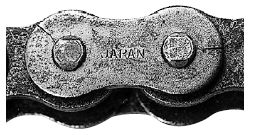 [Click to enlarge ] |
Corrosion stress cracks appear (bow-shaped cracks in the link plate) |
|---|
| Cause 1 | The chain is being used in an acidic or alkaline environment. (This is not caused by a repetitive load.) |
Solution | Replace with a new chain, and protect the chain from the ambient environment with a casing. Consider specifications with greater resistance to stress corrosion fracturing. |
|---|
Pin related
| Cause 1 | Excessively large shock load | Solution | Reduce shock loads by making the start-up, stopping, and other actions smoother. |
|---|---|---|---|
| Cause 2 | Pin subjected to a repetitive load greater than its fatigue limit | Solution | Eliminate the excessive repetitive load, or increase the chain size/number of strands. |
| Cause 3 | Corrosion | Solution | Use a casing, and clean and lubricate your chain regularly. |
| 13 |
 [Click to enlarge ] |
Pin rotates or begins to protrude |
|---|
| Cause 1 | Excessive load or improper lubrication | Solution | Replace with new chain. Improve the lubrication or loading conditions. |
|---|---|---|---|
| Cause 2 | When a chain is not lubricated properly under heavy loads, abnormal frictional force will develop between pins and bushes, causing the pins to quickly rotate. Operating a chain in this condition will cause the pins to extract and lead to chain breakage. | Solution | Replace with a new chain immediately. Never weld the pins or reuse old pins. (Always dispose of old chains to ensure that they are not reused.) Check the mounting condition of the chain if the pin heads and plate sides are worn as well. |
Bush/roller related
| 14 | Roller and/or bush cracks (falls off) |
|---|
| Cause 1 | Inadequate lubrication | Solution | Replace the chain. Provide adequate lubrication according to the operating conditions |
|---|
| 15 | Roller does not rotate, or unsymmetrical roller wear |
|---|
| Cause 1 | RS25、RS35 | Solution | A bushed chain instead of a roller chain is being used |
|---|---|---|---|
| Cause 2 | The inner plate is moving inward, or the bush is cracked | Solution | Replace the chain. Re-inspect the installation and load conditions |
| Cause 3 | Foreign matter has gotten between the bush and roller | Solution | Remove regularly, and use a casing to protect the chain. |
| Cause 4 | Roller load is excessive. | Solution | Lighten the load, or go a chain size up. |
| Cause 5 | Conveyed goods or foreign matter is accumulating in the frame. | Solution | Remove regularly, and protect the chain with a divider system. |
| Cause 6 | Rust on bushes/rollers. | Solution | Reselect for the appropriate specifications (or material) |
| Cause 7 | Inner plate is moving inwards. | Solution | Replace, reexamine installation, and reexamine load. |
| 16 | Roller is opening up |
|---|
| Cause 1 |
Overload |
Solution | Reduce the load, and provide adequate lubrication |
|---|
| 17 | Roller is becoming hourglass shaped |
|---|
| Cause 1 | Excessive load or inadequate lubrication | Solution | Replace with new chain. Improve the lubrication or loading conditions. |
|---|
